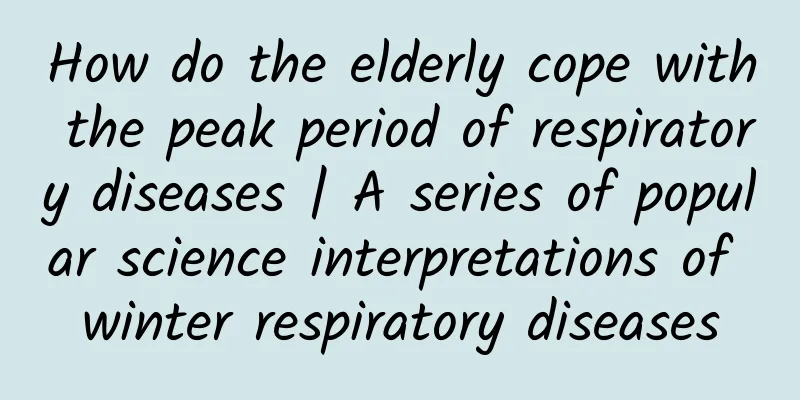How do the elderly cope with the peak period of respiratory diseases | A series of popular science interpretations of winter respiratory diseases

|
Editor's note: Recently, Guangming Online's Science Channel and the "Dayi Xiaohu" medical communication think tank launched a special topic called "Winter Respiratory Disease Series Popular Science Interpretations", inviting medical experts to provide popular science interpretations on the causes, transmission routes, prevention measures and treatments of respiratory diseases. Please pay attention. Author: Li Qingqing, Emergency Department, Shanghai Fifth People's Hospital, Fudan University Scientific review: Shen Jian, Yueyang Hospital of Integrated Traditional Chinese and Western Medicine, Shanghai University of Traditional Chinese Medicine The Chinese New Year is approaching, and emergency rooms in hospitals across the country are overcrowded with patients, with the elderly and children being the hardest hit. At this critical moment, let us discuss how the elderly can cope with the peak period of respiratory diseases in winter and spring. For these patients with fever, as soon as they arrive at the hospital, they are generally tested for influenza A, influenza B, mycoplasma and other pathogen antibodies. We found that some people were mycoplasma positive, many were influenza A positive, some were influenza B positive, and some even had mixed infections, with two to three infections combined. Some of them had signs of lung inflammation on chest X-rays or lung CT scans. Some people's tests showed elevated white blood cell counts, while some did not. For this epidemic of respiratory infections, each patient may be infected with different types of pathogens, so targeted medication and symptomatic treatment are required accordingly. Characteristics and treatment of mycoplasma infection Mycoplasma is neither bacteria nor virus, but the smallest prokaryotic pathogenic microorganism between them. Currently, more than 60 species of mycoplasma have been discovered, among which Mycoplasma pneumonia is the main culprit causing mycoplasma pneumonia. Epidemic characteristics of mycoplasma pneumonia: Fast transmission: It is widely present in nature and can spread rapidly in communities and nursing homes through droplets and contact. Long incubation period: The virus can remain latent for 1 to 3 weeks after infection, which can easily lead to further expansion of the scope of transmission. Long infectious period: It is contagious from the incubation period to the weeks when symptoms are relieved. The epidemic season is mostly in autumn and winter. Mycoplasma pneumoniae can be widely prevalent due to the above four characteristics. The respiratory symptoms of mycoplasma pneumonia are fever and cough. Coughs are mostly paroxysmal dry coughs, and a few have sticky sputum. The cough will gradually worsen and spasmodic coughs will occur. The course of the disease can last for 2 weeks or even longer. Severe cases may be accompanied by pleural effusion and atelectasis. Some elderly people with low immunity are in critical condition and develop rapidly. Respiratory distress may occur and even respiratory support may be required, which can lead to death. Methods for rapid and accurate diagnosis of mycoplasma infection include mycoplasma culture, serological examination, mycoplasma antigen test, and mycoplasma nucleic acid test. Among them, the simplest and most feasible is serological examination. Antibody IgM is an indicator of recent infection. Generally, it begins to rise within 1 week of the initial infection, reaches a peak in 3 to 4 weeks, and gradually decreases in 1 to 3 months. **The main treatment methods for mycoplasma infection: **General and symptomatic treatment: get enough rest, ensure water and electrolyte balance, and use appropriate oxygen therapy; take antipyretics correctly, such as acetaminophen; for severe cough, nebulizer preparations can be used to assist mechanical expectoration, percussion expectoration and other physical methods; anti-infection treatment: early, sufficient, and sufficient course of anti-mycoplasma treatment, such as azithromycin, 0.5g at a time, once a day, for 3 consecutive days; some elderly critically ill patients can be treated with glucocorticoids and immunoglobulins. For azithromycin, we should pay attention to the interaction with other drugs such as compound licorice mixture. When azithromycin and compound licorice mixture are used at the same time, it may cause rapid heartbeat, palpitations, and prolonged QT interval on the electrocardiogram. Characteristics and treatment of influenza virus infection Influenza viruses are divided into four types: A, B, C, and D. The most common are types A and B. Influenza A and B viruses are the protagonists of influenza epidemics. For example, influenza A, also known as influenza A, is an acute respiratory infectious disease caused by influenza A virus. Characteristics of influenza A and influenza B 1. The incubation period is generally 1 to 7 days, mostly 2 to 4 days. The patient is contagious at the end of the incubation period and is highly contagious on the 3rd to 5th day of onset. The contagious period is longer in people with pneumonia and low immunity. 2. Transmission routes: through droplets such as sneezing and coughing; through direct or indirect contact with mucous membranes such as the mouth, nose, and eyes; and through contact with objects contaminated by the virus; in relatively closed places with poor air circulation, the virus can be transmitted in the form of aerosols. 3. Clinical features: sudden high fever, obvious aversion to cold; severe headache, body aches; persistent fatigue, weakness; chest pressure, etc. Whether it is influenza A or influenza B, the symptoms are almost the same clinically and it is difficult to distinguish them. They mainly show fever, cough, sore throat, body aches, etc., while influenza A may also have diarrhea, abdominal pain, etc., while influenza B is more likely to have eye pain. Generally speaking, a variety of pathogens of upper respiratory tract infection may cause such symptoms. Therefore, it is difficult to judge whether it is influenza virus infection based on symptoms alone, let alone whether it is influenza A or influenza B infection. To confirm the diagnosis, blood tests or respiratory mucus tests are required. The simplest and most common way is the screening of influenza A and influenza B antigens. **Treatment of influenza A and influenza B: **General treatment: The patient should pay attention to rest, drink plenty of water, gargle with salt water to keep the mouth, nose and pharynx clean; give antipyretic and analgesic drugs when the temperature exceeds 38.5°C; cough suppressants can be given when coughing, such as compound licorice mixture, loquat juice, etc.; antiviral drugs, such as oseltamivir, a specific drug for influenza A, twice a day, 75 mg each time. In principle, the sooner the anti-influenza virus treatment is, the better, preferably within 24 hours of onset. A bacterial infection often occurs several days after a viral infection, indicating an increase in white blood cell count. At this time, antibiotics such as cephalosporins can be used appropriately. While using the drugs reasonably and in a standardized manner, attention should also be paid to drug interactions. In winter and spring, when there are multiple pathogens with high incidence, the elderly should take good protection 1. Keep warm and wear a mask if necessary; 2. Pay attention to hand hygiene and wash your hands frequently; 3. Take in enough fresh fruits and vegetables, supplement vitamin C, drink plenty of water, and keep enough drinking water; 4. Exercise appropriately to strengthen immunity; 5. Pay attention to the ventilation of the room and avoid areas where people gather or where the air is not circulating; 6. Get influenza vaccine as needed, especially for the elderly and infirm. |
<<: Glioblastoma: Unveiling the mystery of the source of life
Recommend
Does moxibustion work for uterine fibroids?
Surgery is currently the most common method for t...
Can I still get pregnant with a right adnexal cyst?
Women of childbearing age often suffer from some ...
When is the due date for pregnancy in May?
Pregnancy is a very difficult thing, but it is al...
When is March 3, 2020 in the lunar calendar? Is March 3, 2020 a good date to get a marriage certificate?
2020 is a new year. When we make some important l...
Can I get pregnant if the sperm can't be ejaculated and leaks out?
When a couple has sex, the man's sperm cannot...
Why does a woman pee while standing?
Do you have any quirks when taking a bath? Everyo...
Where can I buy Heytea sandwich cookies? What do Heytea sandwich cookies taste like?
Heytea sandwich squares are now available on the ...
What can you eat during confinement?
Diet during the confinement period is very import...
Is it true that women use white vinegar to enlarge their breasts before going to bed?
White vinegar is a commonly used seasoning in the...
Wearing black underwear makes you more likely to get cancer? The truth behind "Don't buy black underwear" is revealed
Black is one of the most common colors in textile...
What should pregnant women do if they have low placental bleeding?
Pregnancy is a process that every woman must go t...
Women's "butterfly shoulder" is a beautiful lie. How to recover and treat it? (I)
The hot weather makes the beautiful backs and sho...
How to treat acne on the forehead? These methods can remove acne
Acne is probably the natural enemy of all women. ...
I used to have breast pain before period and now my nipples hurt. Why?
When women have their period, the hormones in the...
This disease is rare but has a huge impact on life! If there are 3 situations, be sure to pay attention!
October 10th of each year is World Mental Health ...









